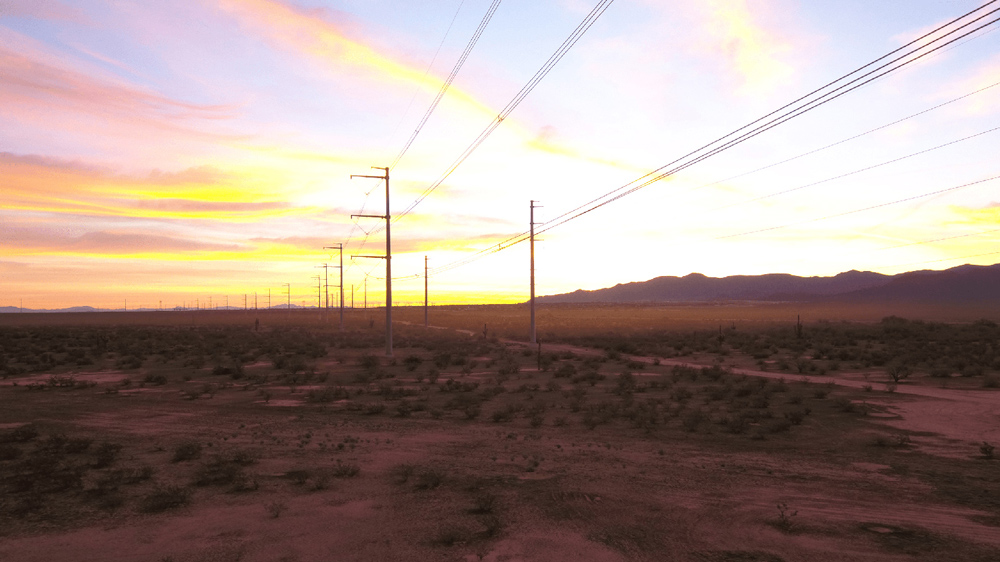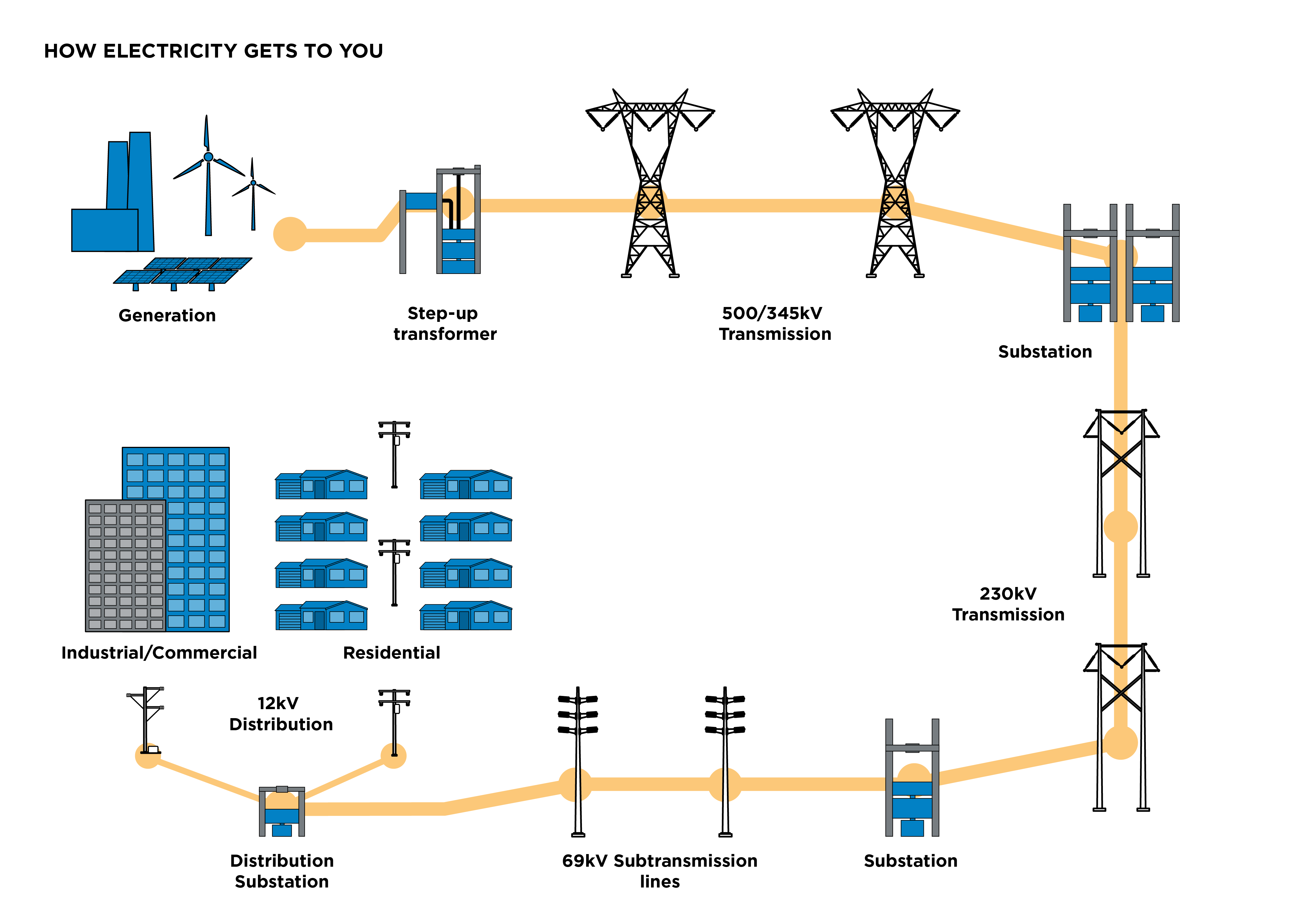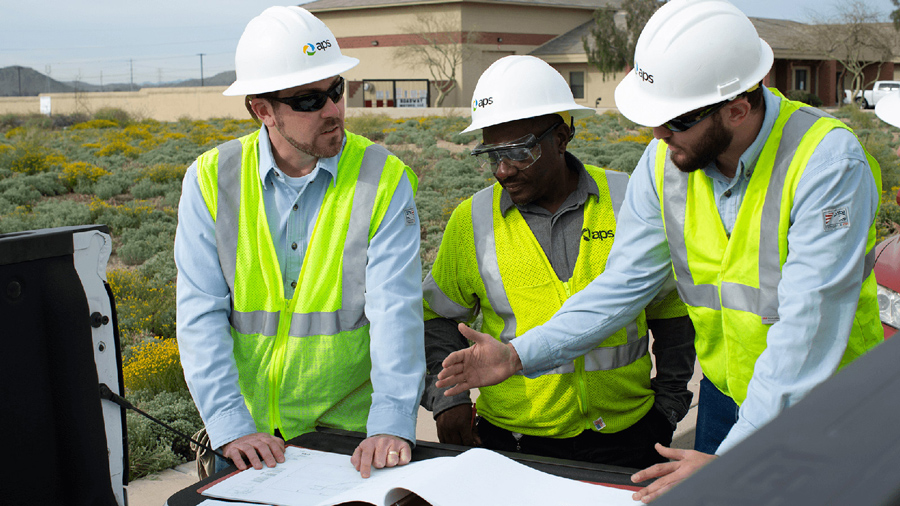Header
Power Line Siting FAQ

Frequently Asked Questions about Power Line Siting
In today’s world, electricity is manufactured in many different ways, from large-scale remote power plants, all the way to local small-scale renewable energy sources. However, the bulk of electricity, no matter where it is generated, travels over long distances through a system of transmission and distribution lines which carry the electricity to where it is needed, and substations that convert the voltage to an amount usable by a specific customer. This diagram gives an approximation of the path that electricity takes between where it is manufactured and a typical customer.


For transmission lines 115kV or greater, APS is required to obtain a Certificate of Environmental Compatibility (CEC) from the Arizona Corporation Commission (ACC).
Siting for lower voltage lines do not require approval by the State of Arizona, nor by individual communities; however in most cases APS follows a similar public siting process to determine where 69kV lines will be located.
Siting for lower voltage lines do not require approval by the State of Arizona, nor by individual communities; however in most cases APS follows a similar public siting process to determine where 69kV lines will be located.
60 Hertz (Hz) electric and magnetic fields (known as “EMF”) are produced by all devices which use, carry, or produce electricity, including household appliances, office equipment, power lines, and wiring in buildings. These are actually two separate fields; the electric field is caused by the voltage on a conductor, while the magnetic field is caused by the current flowing in a conductor.
For power lines this means that the electric field is relatively constant (since the voltage of a power line does not fluctuate), while the magnetic field varies throughout time depending on the current flowing in the power line (this is a function of how much electricity our customers are using at any given time). The strength of both fields decreases as distance from the source increases. In addition, the electric field is easily shielded by solid objects such as buildings or trees, while the magnetic field is generally not shielded by these objects.
Due to these factors, and the fact that high voltage power lines are placed on poles high in the air, the field strengths at ground level near high voltage power lines, particularly the magnetic field strengths, are often similar to those encountered in close proximity to common household, school, and office electrical appliances.
There have been scientific studies on the potential health effects of EMF for more than 25 years. For a more thorough understanding of this research we recommend reviewing web sites of organizations such as the National Institute of Environmental Health Sciences and the World Health Organization (WHO). The WHO website, as of March 2017, states, “Extensive research has been conducted into possible health effects of exposure to many parts of the frequency spectrum. All reviews conducted so far have indicated that exposures below the limits recommended in the ICNIRP (1998) EMF guidelines, covering the full frequency range from 0-300 GHz, do not produce any known adverse health effect.”
APS recognizes that research into potential health effects from exposure to EMF is ongoing and we try to respond appropriately. We follow this research closely and over the years we have helped to fund, and have participated in some of this research. We also include EMF considerations into the design and siting of new power lines or structures. In addition, we can provide educational materials and field strength information on existing and proposed power lines as necessary. All of our construction standards and practices meet or exceed the nationally accepted standards of the National Electrical Safety Code.
Electric and Magnetic Fields
For power lines this means that the electric field is relatively constant (since the voltage of a power line does not fluctuate), while the magnetic field varies throughout time depending on the current flowing in the power line (this is a function of how much electricity our customers are using at any given time). The strength of both fields decreases as distance from the source increases. In addition, the electric field is easily shielded by solid objects such as buildings or trees, while the magnetic field is generally not shielded by these objects.
Due to these factors, and the fact that high voltage power lines are placed on poles high in the air, the field strengths at ground level near high voltage power lines, particularly the magnetic field strengths, are often similar to those encountered in close proximity to common household, school, and office electrical appliances.
There have been scientific studies on the potential health effects of EMF for more than 25 years. For a more thorough understanding of this research we recommend reviewing web sites of organizations such as the National Institute of Environmental Health Sciences and the World Health Organization (WHO). The WHO website, as of March 2017, states, “Extensive research has been conducted into possible health effects of exposure to many parts of the frequency spectrum. All reviews conducted so far have indicated that exposures below the limits recommended in the ICNIRP (1998) EMF guidelines, covering the full frequency range from 0-300 GHz, do not produce any known adverse health effect.”
APS recognizes that research into potential health effects from exposure to EMF is ongoing and we try to respond appropriately. We follow this research closely and over the years we have helped to fund, and have participated in some of this research. We also include EMF considerations into the design and siting of new power lines or structures. In addition, we can provide educational materials and field strength information on existing and proposed power lines as necessary. All of our construction standards and practices meet or exceed the nationally accepted standards of the National Electrical Safety Code.
Electric and Magnetic Fields
Transmission line noise can be described as humming or crackling. Audible noise from the power lines is created by:
• Corona discharge along the line
• Frequency and voltage level of the line
Corona is defined as the breakdown of air into charged electrical particles. The amount of corona for a transmission line is a function of several things including:
• Engineering design
• Voltage
• Phase spacing and geometry
• Weather conditions
Effects of corona can include:
• Audible noise
• Radio and TV interference
Suggested noise levels:
• Electric Power Research Institute (EPRI) studies show that customer complaints are registered at 52.5 decibels, A-weighted (dB(A))
• The Environmental Protection Agency (EPA) has concluded that day/night (Ldn) sound levels below 55.0 dB(A) will not cause interference or annoyance with outdoor activities.
Noise levels on a typical extra-high voltage transmission line are expected to be less than the suggested levels.
• Corona discharge along the line
• Frequency and voltage level of the line
Corona is defined as the breakdown of air into charged electrical particles. The amount of corona for a transmission line is a function of several things including:
• Engineering design
• Voltage
• Phase spacing and geometry
• Weather conditions
Effects of corona can include:
• Audible noise
• Radio and TV interference
Suggested noise levels:
• Electric Power Research Institute (EPRI) studies show that customer complaints are registered at 52.5 decibels, A-weighted (dB(A))
• The Environmental Protection Agency (EPA) has concluded that day/night (Ldn) sound levels below 55.0 dB(A) will not cause interference or annoyance with outdoor activities.
Noise levels on a typical extra-high voltage transmission line are expected to be less than the suggested levels.
Placing high and extra-high voltage power lines underground is significantly more expensive than placing power lines overhead. This is due to additional required construction plus the use of special materials and conductors required for underground use. In particular, trenching or boring for the entire length of the power line can be difficult and expensive. Depending on the voltage and the location of the power line and considering the inability to be cooled by the ambient (surrounding) air as in an overhead configuration, underground power lines may require special technology to keep the wires cool. This technology may include oil or gas filled pipe type conductor, forced and refrigerated oil cooled piping and forced airflow.
Buried power lines can also extend power outages, as it may take additional time to locate a specific power issue, and take more time to access the fault and repair it. Additionally, underground systems can be prone to flooding in certain conditions.
Typically, lower voltage (distribution) lines are buried with new developments, as the additional cost to place the lines underground is passed onto home buyers or business owners by the developer through impact fees.
Buried power lines can also extend power outages, as it may take additional time to locate a specific power issue, and take more time to access the fault and repair it. Additionally, underground systems can be prone to flooding in certain conditions.
Typically, lower voltage (distribution) lines are buried with new developments, as the additional cost to place the lines underground is passed onto home buyers or business owners by the developer through impact fees.
To help keep prices lower for all customers, and provide efficient access to our systems, our standard practice is overhead construction for transmission lines. However, there may be instances where underground installation takes place, such as through development agreements or where individual customers have paid for the lines to be placed underground through a utility facilities improvement district that is established by municipal and/or county authorities. The local municipal authority may establish an improvement district if approved by a majority of affected property owners. A district is a taxing authority, taxing affected property owners in order to raise funds for the additional cost of placing cables underground (See A.R.S. § 48-620).
There are multiple reasons why new power lines may be needed in an existing area.
One common possibility is due to nearby growth. APS’s system is set up as a grid. This means that through an interconnected set of substations and power lines, power is delivered from the bulk source to the eventual customer. In most cases, there are redundant paths for the electricity to make it to the customer. However, as the system is a grid, this may mean that an additional power line is needed in an already connected area to bolster the already existing system to accommodate nearby growth, and to add to the reliability of the system.
In some cases, a neighborhood may be served by a radial (single) line, and APS may be adding a line to provide a second source into the area to improve reliability.
Another reason is due to the fact that as technology plays a larger part in our lives, our customers are using more electricity than ever before, even in established areas.
One common possibility is due to nearby growth. APS’s system is set up as a grid. This means that through an interconnected set of substations and power lines, power is delivered from the bulk source to the eventual customer. In most cases, there are redundant paths for the electricity to make it to the customer. However, as the system is a grid, this may mean that an additional power line is needed in an already connected area to bolster the already existing system to accommodate nearby growth, and to add to the reliability of the system.
In some cases, a neighborhood may be served by a radial (single) line, and APS may be adding a line to provide a second source into the area to improve reliability.
Another reason is due to the fact that as technology plays a larger part in our lives, our customers are using more electricity than ever before, even in established areas.
The number of wires and type of structure are project specific. Typically, there are three wires per circuit on a structure, and in most cases, a structure is built single-circuit (three wires) or double-circuit (six wires). In most situations there also will be one or two smaller wires providing ground or system communication at the top of the structures.
For some voltages (230kV and below) the structures may be underbuilt (rather than having two separate structures) with lower voltage lines on the same structure. For instance, you might have a 230kV power line underbuilt with 69kV, or a 69kV power line underbuilt with 12kV. In this circumstance, you could have a structure that ranges from a single-circuit (three wires) configuration for both voltages, to having double-circuit (six wires) for both voltages. This would result in having 12 wires per plus the smaller ground and system communication wires at the top of the structure.
For some voltages (230kV and below) the structures may be underbuilt (rather than having two separate structures) with lower voltage lines on the same structure. For instance, you might have a 230kV power line underbuilt with 69kV, or a 69kV power line underbuilt with 12kV. In this circumstance, you could have a structure that ranges from a single-circuit (three wires) configuration for both voltages, to having double-circuit (six wires) for both voltages. This would result in having 12 wires per plus the smaller ground and system communication wires at the top of the structure.
What do typical transmission structures look like?
The photographs below are examples of typical structures in the APS system.

230kV Double-Circuit Lattice

230kV Double-Circuit Monopole with Double-Circuit 69kV Underbuild

230kV Single-Circuit Lattice

500kV Single-Circuit Lattice

500kV Single-Circuit Monopole

69kV Double-Circuit Monopole

69kV Double-Circuit Monopole with 12kV Underbuild

More Resources
For more information visit one of the following websites:
Arizona Power Plant and Transmission Line Siting Committee
Arizona Corporation Commission
Arizona Revised Statues 40-360








